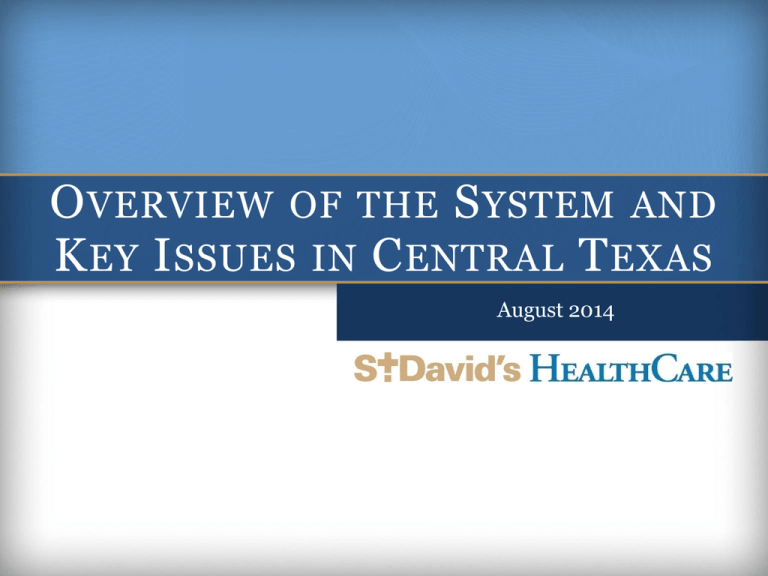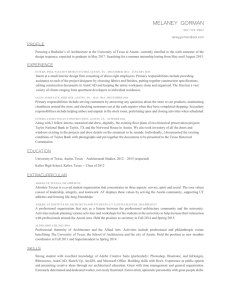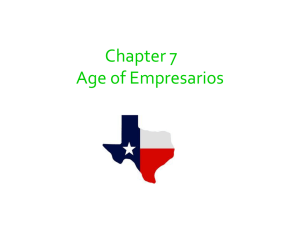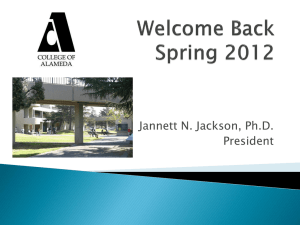View - Leadership Austin
advertisement

O VERVIEW OF THE S YSTEM AND K EY I SSUES IN C ENTRAL T EXAS August 2014 Geographic Footprint Introduction and Overview 5 General Acute Care Hospitals 1 Specialty Heart Hospital 1 Specialty Rehab Hospital 5 Ambulatory Surgery Centers UC GEORGETOWN ROUND ROCK 4 Freestanding EDs 4 Urgent Care Centers UC UC AUSTIN BEE CAVE UC BASTROP UC KYLE 2 Organizational Structure Introduction and Overview 50/50 Governance Mgmt Services Mgmt Fee St. David’s Medical Center St. David’s South Austin Medical Ctr St. David’s North Austin Medical Ctr St. David’s Round Rock Med Ctr St. David’s Medical Group St. David’s Georgetown Hospital FSED – Bee Cave St. David’s Women’s Ctr of Texas FSED – Cedar Park St. David’s Heart & Vascular Heart Hospital of Austin FSED – Bastrop Texas Institute for Robotic Surgery ASC – Oakwood St. David’s Primary Care St. David’s Rehab Hospital Texas Cardiac Arrhythmia Institute NeuroTexas Institute ASC – Surgicare FSED - Pflugerville ASC – NASC Clinical Affiliates: Central Texas Med Ctr St. Mark’s Med Ctr St. David’s Specialty Practices ASC – San Marcos (JV) Hill Country Mem’l Hosp Columbus Comm. Hosp ASC – Bailey Sqr Comanche County Med Ctr 3 Ownership, Governance and Funding Model Introduction and Overview Unique Business Model Excess Earnings from Operations THE COMMUNITY Jointly governed (50:50) by HCA and St. David’s Foundation, this unique business model has allowed St. David’s Foundation to contribute more than $218M back into the community since the formation of the Partnership in 1996 4 The Issues: Indigent and Unfunded Care Introduction and Overview Texas: highest rate of uninsured in the nation (1 in four Texans lacks coverage) 3.9 million Texans in Medicaid ‒ Up 80% in past ten years (vs. state pop growth of 20%) ‒ Largely a women’s and children’s program ‒ 1 million of the nation’s 7 million uninsured who could qualify for Medicaid reside in Texas The region’s public health entity (Central Health) cares for 34% of uninsured/indigent ‒ Burden largely carried by private providers Medicaid 1115 Waiver provides reimbursement for uncompensated care costs in the state’s safety net and an opportunity for innovation in healthcare delivery, but we must ensure: ‒ Continued funding ‒ Equitable allocation of funds based on the amount of unfunded care provided St. David’s HealthCare provides nearly 40% of unfunded care in the community ‒ More than $1 Billion in charity care since 1996 Uncompensated Care DSRIP Funds SDH 1% SDH 39% Seton 26% Central Health 35% Seton through the CCC 99% 5 The Issues: Indigent and Unfunded Care Introduction and Overview St. David’s Foundation = $218+ million to agencies and local safety net clinics since 1996 St. David’s Foundation collaborates with more than 60 nonprofit partners to reinvest effectively back into the community In 2014 alone, St. David’s Foundation will invest almost $50 million in the following focus areas: HEALTHY AGING Serving Aging Populations HEALTHY FUTURES Advancing Health Education and Research HEALTHY MINDS Supporting Behavioral Health Programs HEALTHY PEOPLE Investing in Primary and Specialty Care HEALTHY LIVING HEALTHY SMILES Promoting Health and Wellness Mobilizing the St. David’s Dental Program 6 The Issues: Behavioral Health Introduction and Overview Ongoing shortage of behavioral health resources – all of Austin’s psychiatric facilities consistently operate at full capacity ‒ Since its creation, Central Health has placed mental health services in Travis County among its top priorities Community Health Needs Assessment found that the need for mental health services was one of the foremost community health concerns raised by residents ‒ 21% of Travis County residents report mental health needs Key stakeholders have collaborated to address behavioral health needs in our community A number of behavioral health projects were supported using DSRIP (Delivery System Reform Incentive Payment) funds ‒ St. David’s HealthCare initiated a telepsychiatry program (March 2014) • Estimated encounters over first three years = 16,000 St. David’s Foundation awarded $8.9 million to ATCIC to build and operate a mental health crisis center (August 2014) Opportunity to apply more of Waiver and Central Health resources to this issue 7 The Issues: Growth/Demand Introduction and Overview The Growth of Austin Fastest growing city in the fastest growing state in the nation ‒ 1,000 people move to Texas every day; 150 people move to Austin every day ‒ 2.8% 5-year CAGR (1.7%: Texas, 0.8% in US) Population shifting rapidly to Medicare ‒ 65+ Population 15.4% 5-year CAGR (12.2%: TX, 10.5%: US) ‒ Medicare is 95% of inpatient utilization growth over last three years Projected CAGR of inpatient utilization = 1.5% vs. 0.6% in Texas and negative in US (Sg2) Investing in Austin Capital Investments: $1.325B since formation of St. David’s HealthCare in 1996 ‒ Without incurring debt ‒ Without raising funds from the community State and Local Taxes: $221 Million since 1996 ‒ Local side of Partnership doesn’t pay federal income tax but does pay property taxes, sales taxes and the Texas margin tax 8 The Issues: Growth/Demand Introduction and Overview Facility Expansions Launched Blood Cancer program and dedicated oncology unit at St. David’s South Austin Medical Center Initiated ICU expansion at St. David’s Medical Center Continuing multi-year facility renovation plan at St. David’s South Austin Medical Center Expanding maternal and neonatal services at Women’s Center of Texas Completed ER expansion and renovation at St. David’s North Austin Medical Center Opened freestanding emergency center in Cedar Park World-Class Programs Texas Cardiac Arrhythmia Institute Texas Institute for Robotic Surgery St. David’s Maternal and Neonatal Services and the St. David’s Women’s Center of Texas at St. David’s North Austin Medical Center NeuroTexas Institute St. David’s Rehabilitation Hospital Heart Hospital of Austin 9











